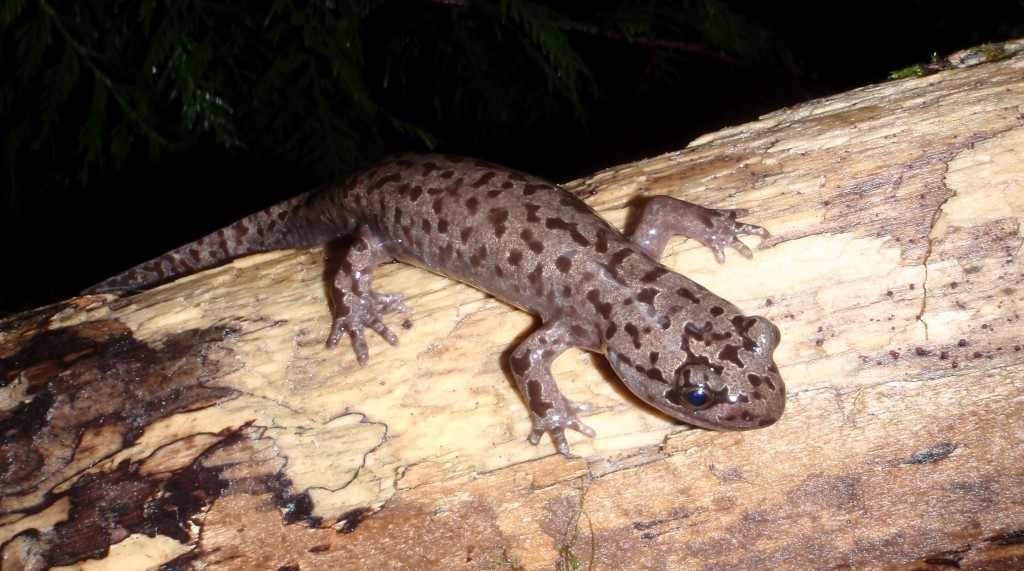Dr. Rachael Dudaniec
Address: Department of Forest Sciences, 3041 – 2424 Main Mall
University of British Columbia, Vancouver, B.C. V6T 1Z4
Email: Rachael
Phone: (604) 822-8927
Position: Post-doctoral Fellow
PhD (2008) – Flinders University, Australia
I am interested in using molecular tools to examine the ecology and population dynamics of threatened species in order to make informed conservation recommendations. By integrating ecological with molecular techniques, aspects of a species’ dispersal and reproductive behaviour can be elucidated, while providing a picture of population connectivity, sustainability and habitat use. My post-doctoral research focuses on the conservation genetics of the Coastal Giant Salamander (Dicamptodon tenebrosus) in logged forests of British Columbia. In BC, D. tenebrosus is threatened by forestry practices and occurs in approximately 60 streams covering 100 km2 of the Chilliwack River Valley. Genetic markers (microsatellites) will be used in combination with ecological and environmental data to examine the impacts of varying forest treatments (e.g. selective logging, clear-cuts, second growth vs old growth forest) on dispersal, inbreeding, social behaviour, and population dynamics of D. tenebrosus. It is anticipated that this research will ultimately lead to the implementation of effective forestry and conservation strategies (e.g. Wildlife Habitat Areas) to assist recovery, and prevent decline of Canadian populations of D. tenebrosus.
Dudaniec R Y, Richardson J S (in review) Multi-scale habitat relationships in a threatened salamander (Dicamptodon tenebrosus) at its northern range limit.
Dudaniec R Y, Schlotfeld B E, Donnellan S C, Bertozzi T, Kleindorfer S. (in review) Genetic divergence supports morphological subspecies of island and mainland superb fairy-wrens (Malurus cyaneus subspp.).
Dudaniec R Y, Storfer A, Spear S, Richardson J S (2010) New microsatellite markers for examining genetic variation in peripheral and core populations of the Coastal Giant Salamander (Dicamptodon tenebrosus). PLoS ONE.
O’Connor J, Dudaniec R Y, Kleindorfer S (2010) Parasite infestation and predation in Darwin’s small ground finch: contrasting two elevational habitats between islands. Journal of Tropical Ecology. 26: 285-292.
Dudaniec R Y, Gardner M G, Kleindorfer S (2010) Offspring genetic structure reveals mating and nest reinfestation behaviour of an invasive parasitic fly (Philornis downsi) of Galapagos birds. Biological Invasions 12: 581-592.
Kleindorfer S, Dudaniec R Y (2009) Love thy neighbour? Social nesting pattern, host mass and nest size affect ectoparasite intensity in Darwin’s tree finches. Behavioural Ecology and Sociobiology 63: 731-739.
Dudaniec R Y, Gardner M, Kleindorfer S (2008) Genetic variation in the invasive avian parasite, Philornis downsi (Diptera, Muscidae) on the Galápagos archipelago. BMC Ecology 8: 13-25. DOI:10.1186/1472-6785-8-13
Dudaniec R Y, Gardner M G, Kleindorfer S (2008) Isolation, characterisation and multiplex PCR of novel microsatellite loci for the avian parasite, Philornis downsi (Diptera: Muscidae). Molecular Ecology Resources 8: 142-144.
Dudaniec R Y, Kleindorfer S, Fessl B (2007) Inter-annual and inter-specific variation in intensity of the parasitic fly, Philornis downsi, in Darwin’s finches. Biological Conservation 139: 325-332.
Gardner M G, Sanshez J J, Dudaniec R Y, Rheinberger L, Smith A L, Saint K M (2007) Tiliqua rugosa microsatellites: isolation via enrichment and characterisation of loci for multiplex PCR. Conservation Genetics. DOI: 10.1007/s10592-007-9316-0
Dudaniec R Y, Kleindorfer S, Fessl B (2006) Effects of the introduced ectoparasite Philornis downsi on haemoglobin level and nestling survival in Darwin’s Small Ground Finch (Geospiza fuliginosa). Austral Ecology. 31: 88-94.
Dudaniec R Y, Kleindorfer S (2006) The effects of the parasitic flies of the genus Philornis (Diptera: Muscidae) on birds. Emu, Austral Ornithology. 106: 13-20.
Kleindorfer S, Dudaniec R Y (2006) Increasing prevalence of avian poxvirus in Darwin’s finches and its effect on male pairing success. Journal of Avian Biology. 37: 69-76.
Dudaniec R Y, Hallas G, Kleindorfer S (2005) Blood and intestinal parasitism in Darwin’s finches: negative and positive findings. Acta Zoologica Sinica. 51: 507-512.

